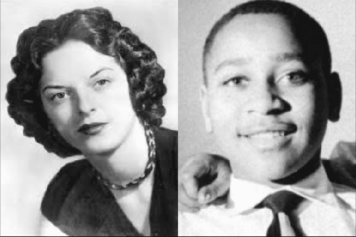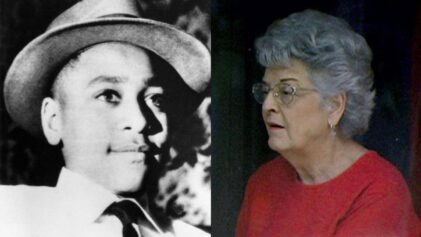
In a significant move towards finally accepting this brutal past, Sumner, Mississippi, over the weekend dedicated a museum to tell the world about Emmett Till and his horrific death in August 1955, which historians point to as the match that sparked the burning rage of the Civil Rights Movement.
For at least two generations of African-Americans, Emmett Till has been a reference point for the depths of hate.
The Emmett Till Interpretive Center opened its doors on Saturday with a significant ceremony attended by local luminaries and members of Till’s family. The opening of the museum was timed to coincide with the reopening across the square of the Tallahatchie County Courthouse, which was restored to the way it looked when an all-white jury took just one hour in September 1955 to set free the men who killed Emmett, J.W. Milan and Roy Bryant. They claimed they were getting revenge after the 14-year-old boy supposedly whistled at Bryant’s wife, a claim widely debunked.
Months after their acquittal, they confessed to the crime in a paid interview with Look magazine.
Tallahatchie County is no longer trying to flee the ugliness for which it became known across the world. The town of Sumner has embraced it—and is now turning it into something of a tourist attraction. The hate that drove Black people away is now being used to attract them. There are historical markers, a civil rights driving tour, and even a smartphone app being developed that will guide visitors to the sites related to the Till case and tell the stories surrounding it.
“Unlike traditional memorials, our app is not simply a means of reflecting on the past,” Dave Tell, associate professor of communication studies at Kansas University and one of those assisting in the app’s development, told The Clarion-Ledger. “It is also designed to foster reflection on the political stakes of commemoration.”
While commemoration can’t erase the vicious terrorism of the past, public acknowledgement can be of crucial importance to the community, according to experts. In its chilling report on lynchings in the South called “Lynching in America: Confronting the Legacy of Racial Terror,” the Alabama-based Equal Justice Initiative said this about the need for public memorials: “Erecting monuments and memorials to commemorate lynching can begin to correct our distorted national narrative about this period of racial terror in American history while directly addressing the harms borne by the African American community, particularly survivors who lived through the lynching era. Scholars who have studied the impact of human rights abuses emphasize that speaking out about victimization can have a significant healing impact on survivors of genocide, mass violence and other harms. Continued silence about lynchings ‘compounds victimization’ and tells victims and the nation as a whole that ‘their pain does not matter.’ Publicly acknowledging lynchings can link instances of individual loss and harm to a broader system of abuse and mass violence and empower affected individuals ‘to move beyond trauma, hopelessness, numbness, and preoccupation with loss and injury.'”
No other state lynched more people than Mississippi, according to the EJI’s research, so no other place is more in need of healing than Mississippi. Till’s death was so harrowing that its details haunted a generation of Black children—and adults—not just in Mississippi but across the South and the nation.
The teen from Chicago was visiting relatives in Money, Mississippi, when he went into a small grocery store owned by 21-year-old Carolyn Bryant and her husband Roy. Till spoke to the woman, which was enough to inspire Roy and his half-brother J. W. Milam to hunt Till down. They dragged him from his great-uncle’s house and secreted him away to a barn, where they beat him and gouged out one of his eyes. Then they shot him through the head and disposed of his body in the Tallahatchie River, putting a 70 lb. cotton gin fan around his neck with barbed wire to weigh his body down.
His grossly disfigured body was discovered in the river three days later.
In Chicago, Till’s mother insisted on having a public funeral with an open casket so the world could see how her son had been brutalized. Tens of thousands attended his funeral and millions more saw the pictures published in JET magazine, horrifying a nation.
Till’s cousin, Wheeler Parker of Chicago, spoke at the weekend ceremony. “When history is recorded, these people are going to be remembered,” he said, according to the Clarion-Ledger. “Emmett Till still speaks — loud and clear.”
The courthouse restoration was singled out for special praise by two men who attended the trial, longtime state Sen. David Jordan and journalist Bill Minor, who covered the trial.
Minor pointed to the jury room and said he remembered hearing laughter from the room during deliberations.
The community tried for decades to erase this history, but now it has been memorialized for future generations to know what happened.
“They wanted to do away with the memory,” said Holly Hawkins, project manager for the courthouse renovation.
“For a long time, the people in Tallahatchie County were afraid to even talk about it,” said John Wilchie, co-chairman of the Emmett Till Memorial Commission.
This was the next step after the formal apology the county issued to the Till family in 2007 outside the courthouse.
“We are profoundly sorry for what was done in this community to your loved one,” the apology said. “We the citizens of Tallahatchie County acknowledge the horrific nature of this crime. Its legacy has haunted our community. We need to understand the system that encouraged these events and others like them to occur so that we can ensure that it never happens again.”

